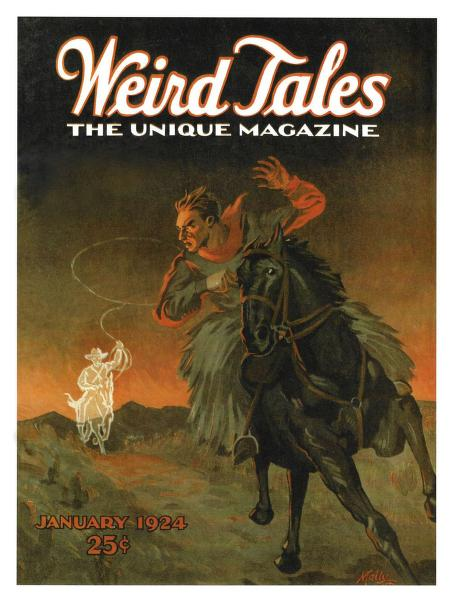Last year, I kicked off an effort to increase my reading of old pulp magazines, with a particular focus on those issues celebrating their centenary (i.e., issues from 1923). I started the focused project with Volume 1, Issue 1 of Weird Tales, as that famed magazine began publication in early 1923, and all issues from its original run (through 1954) can be found easily in electronic format because copyrights were not renewed, but I’m reading a wide variety of pulps depending on availability to me either electronically or in print (either original issues or facsimiles). My goal this year is to read one hundred-year-old pulp issue per week, and to the extent possible close to the issue’s date (e.g., February issues in February).
To get things started for this year, I read the December 1923/January 1924 issue of Weird Tales (dated January 1924 on the cover), a 96-page issue with cover art by R. M. Mally. The magazine contains what at the time was its usual mix of stories involving crime, the supernatural, or science fiction, plus poetry, a bit of “true crime,” and short items of current news related to the strange and unusual, particularly in science or crime. Overall, the stories are mediocre, but there are some that manage to be fairly entertaining.
The issue opens with the first portion of a two-part story, “The Abysmal Horror,” by B. Wallis, an apocalyptic tale that reminds me so far of John Wyndham’s later, and much better, The Day of the Triffids. The writing is lackluster, but I am interested in reading the second part to see how the story turns out. Much weaker was the other serial in the issue, Part 2 of John Martin Leahy’s “Draconda,” relating the outcome of a trip to Venus. Despite some action, the pace is plodding, and I’m not looking forward to having to trudge through four more parts.
The novelettes in the issue are a mixed bag. “Black Sorcery,” by Paul Annixter, is perhaps the weakest, a tale of dark magic and death in East Africa. And Ledyard M. Bailey’s “The Cobra Lily” offers a rather clichéd account of a hunt for botanical specimens in the Yucatan and the consequences of the theft of one plant; the story is further weakened by a rationalization of what had appeared unusual or even supernatural. On the other hand, Mrs. Harry Pugh Smith’s “The Hook of Death” is a straightforward story of the investigation of an ostensibly haunted house by its new owner. This one would perhaps have benefited from a few more pages of development of characters and plot, but it satisfied as a non-weird tale.
The short stories are generally disappointing, though the worst of the lot is probably “A Game of Chance,” by Henry Lieferant and Sylvia B. Saltzberg, in which an intern recounts the overnight happenings in a hospital’s morgue. H. P. Lovecraft’s “The Picture in the House,” previously published in the July 1919 issue of The National Amateur, has a rushed ending but does at least offer the reader a glimpse of the author’s haunted New England. Still the best of the short stories by far is this issue’s “Masterpiece of Weird Fiction,” Edgar Allan Poe’s “The Black Cat.” “Weird Crimes: No. 3. The Magic Mirror Murders,” by Seabury Quinn, is a well-told true-crime story of serial killings in Bavaria during the Napoleonic Era; the shorter miscellaneous pieces chiefly dwell on the gruesome but aren’t all that interesting. The poems likewise are undistinguished, though Clark Ashton Smith’s “Solution” may be the best of those in the issue.

